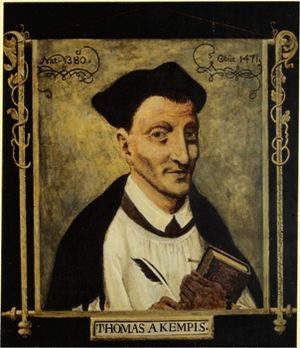Thomas à Kempis facts for kids
Quick facts for kids
Thomas a Kempis
|
|
|---|---|
 |
|
| Born | 1380 Kempen, Prince-Archbishopric of Cologne, Holy Roman Empire
|
| Died | 25 July 1471 (aged 90–91) Zwolle, Bishopric of Utrecht, Holy Roman Empire
|
| Other names | Thomas von Kempen Thomas Hemerken |
| Occupation | Canon regular, author, scribe |
| Known for | The Imitation of Christ |
Thomas à Kempis (born around 1380 – died July 25, 1471) was a famous writer and religious leader. He was from both Germany and the Netherlands. He is best known for writing The Imitation of Christ. This book is one of the most popular Christian books ever written.
His name, "Thomas à Kempis," means "Thomas from Kempen." Kempen was the town where he was born. He was part of a special religious group called the Modern Devotion. This group focused on living a simple and devoted life. He followed the teachings of Geert Groote and Florens Radewyns. They started a community called the Brethren of the Common Life.
Contents
Life Story of Thomas à Kempis
Thomas was born in a town called Kempen in Germany. His family name was Hemerken. This name meant "little hammer," because his father, Johann, was a blacksmith. His mother, Gertrud, worked as a schoolteacher.
Early Education and Religious Path
In 1392, Thomas went to Deventer in the Netherlands. He joined his brother, Johann, to attend a well-known Latin school there. At this school, Thomas met the Brethren of the Common Life. These were people who followed the ideas of Gerard Groote and the Modern Devotion movement. Thomas studied in Deventer from 1392 to 1399.
After school, Thomas moved to Zwolle, a nearby city. He visited his brother Johann again. By then, Johann had become the leader of the Monastery of Mount St. Agnes. This monastery was part of a group called the Congregation of Windesheim. This group was started by followers of Groote. They wanted to live a strict and traditional monastic life.
Thomas joined the Mount St. Agnes monastery in 1406. He became a canon regular, which is a type of priest who lives in a community. He was ordained as a priest almost ten years later, in 1413. He became very good at copying books and writing. In 1429, he was made the sub-prior of the monastery. This meant he helped lead the community.
Life in the Monastery
Thomas spent most of his time praying, writing, and copying manuscripts. He copied the Bible four times! One of his copies, which is in five volumes, is still kept in Darmstadt, Germany. He knew the Bible very well. His own writings are full of quotes from the Bible, especially from the New Testament.
As sub-prior, Thomas was in charge of teaching new members of the monastery. Between 1420 and 1427, he wrote four small books for them. These books were later put together and became his most famous work, The Imitation of Christ. Many important people, like Thomas More, thought this book was essential. Between 1500 and 1700, it was translated into English many times.
Thomas à Kempis passed away near Zwolle in 1471.
Thomas à Kempis's Writings
Thomas à Kempis wrote many important books and texts. His most famous work is The Imitation of Christ. The original handwritten copy of this book from 1441 is kept in the Royal Library in Brussels.
He also wrote life stories of other members of the Modern Devotion movement. These included Gerard Groote, Floris Radewijns, Jan van de Gronde, and Jan Brinckerinck. Some of his other important writings include:
- Prayers and Meditations on the Life of Christ
- Meditations on the Incarnation of Christ
- Of True Compunction of Heart
- Soliloquy of the Soul
- Garden of Roses
- Valley of Lilies
- A Life of St. Lidwina of Schiedam
Famous Sayings
Here are some well-known quotes believed to be from Thomas à Kempis:
- "Without the Way, there is no going, Without the Truth, there is no knowing, Without the Life, there is no living."
- "If you want to learn, read with humility, simplicity, and faith. Don't try to seem smart."
- "On Judgment Day, we won't be asked what we read, but what we did." — From The Imitation of Christ, Book I, chapter 3
- "For man plans, but God decides." — From The Imitation of Christ, Book I, chapter 19
- "If you look for Jesus in everything, you will surely find Him." — From The Imitation of Christ, Book II, chapter 7
A famous saying linked to him is: "In angello cum libello" which means "In a little corner with a little book." A longer version of this saying is: "I have looked everywhere for peace, but I have found it only in nooks and in books."
Honoring Thomas à Kempis
People have honored Thomas à Kempis for centuries. A monument was built to remember him in St. Michael's Church in Zwolle. It was dedicated on November 11, 1897.
Over the years, his shrine (a special place holding his relics) has moved. In 1964, St. Michael's Church closed, and the shrine moved to a new church. In 2005, that church also closed. Now, his shrine is in the Onze-Lieve-Vrouw-ten-Hemelopneming kerk (Assumption of Mary church) in the center of Zwolle.
Images for kids
-
Monument on Mount Saint Agnes in Zwolle "Here lived Thomas van Kempen in the service of the Lord and wrote On the Imitation of Christ, 1406–1471"
See also
 In Spanish: Tomás de Kempis para niños
In Spanish: Tomás de Kempis para niños






